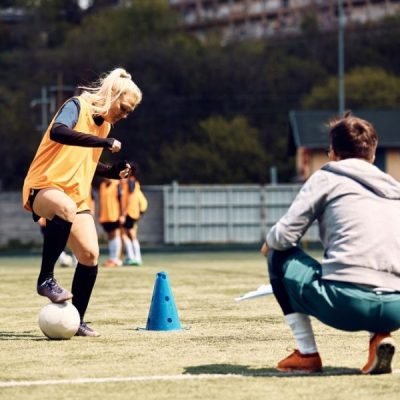Skills Development and Drills
More in-depth articles regarding Skills Development and Drills for women soccer players will be found in the header menu above under “Resources.” The following are short summaries of future articles. They provide basic information on various topics Soccer Talented will cover in the future.
Please note we’ve added basic information that many players have probably been doing for years, but we hope some of the basic information will prove helpful for parents.
Table of Contents
Women’s Soccer Fitness: The Comprehensive Guide to Excelling On and Off the Field
For parents new to the world of soccer or those seeking a deeper understanding of the game, Skills Development, and Drills can seem a bit daunting. These essential components of soccer training are about enhancing a player’s technical abilities and game proficiency through systematic and repeated practice routines.
To bridge this knowledge gap, we’ve broken down some fundamental drills and techniques, providing basic examples that can assist parents in supporting their daughters. By understanding these drills, parents can better appreciate the training process and actively participate in their child’s journey to mastering soccer.
Dribbling Techniques
Mastering dribbling allows players to easily navigate the field, maneuvering the ball away from opponents. Drills like the “cone weaving” help players refine their agility and close ball control. For parents, this translates into observing their child make swift and confident moves during a match.
Passing Precision
Effective passing is the backbone of cohesive team play. By focusing on drills that emphasize “short passes,” “long balls,” and “chip passes,” players learn to distribute the ball with greater accuracy and vision. Parents will notice smoother transitions and fewer turnovers during games.
Ball Control
Solid ball control skills mean players can receive, trap, and manage the ball under pressure. Drills like “juggling” and “first-touch exercises” are integral to cultivating this skill. Parents can assist by practicing simple toss-and-trap exercises with their kids at home.
Shooting Techniques
A goal is the ultimate aim in soccer. Drills that improve shooting accuracy and power are essential. Techniques such as “volleys” and “free kicks” should be practiced regularly. For parents, understanding the importance of a player’s stance and foot positioning can help in casual backyard practices.
Defensive Skills
A strong defense is as valuable as a potent offense. Drills that emphasize “tackling,” “interceptions,” and “positioning” hone a player’s defensive skills. Parents should appreciate the importance of defense, as it’s not just about scoring goals but also preventing them.
Goalkeeping Basics
For those guarding the net, drills that enhance “shot-stopping,” “catching crosses,” and “throwing accuracy” are vital. Parents of budding goalkeepers should invest in suitable gloves and encourage regular hand-eye coordination exercises.
Set Pieces Mastery
Free kicks, corners, and penalties can change the game’s outcome. Players should focus on “wall positioning,” “curving the ball,” and “spot-kick techniques.” Parents can help by understanding the rules and practicing set-piece scenarios.
Off-the-Ball Movement
Soccer isn’t just about the player with the ball. Moving intelligently off the ball creates passing options. Drills like “dummy runs” and “position swapping” improve this skill. Even without soccer experience, parents can help by playing simple passing games and observing movement.
Tactical Awareness
Understanding game strategy and player roles is crucial. Players should be exposed to various formations and learn when to “press” or “hold.” Parents can support this by discussing game strategies post-match and watching professional games with their children.
Speed and Agility
Quick footwork and nimbleness give players an edge. Drills involving “agility ladders”, “cone drills”, and “focused sprints” develop these skills. Parents can facilitate by setting up mini obstacle courses or arranging friendly races.
Building Stamina
Endurance is vital for a 90-minute game. “Endurance drills,” “circuit training,” and “interval runs” help players last the entire match. Parents can support by encouraging regular fitness routines and joining in for morning jogs or bike rides.
Position-Specific Training
Each position on the field has unique demands. Tailored drills ensure that players refine skills specific to their role. Parents can aid by understanding their child’s position specifics and focusing on relevant drills.
Game Analysis
Post-game analysis helps identify areas of improvement. Watching game recordings and discussing tactics is beneficial. Parents can contribute by watching games with their children, offering constructive feedback, and celebrating gains.
Technical Versatility
Players should be comfortable using both feet and performing varied roles if needed. Drills that encourage “ambidexterity” and “role rotation” foster versatility. Parents can motivate their children by challenging them to use their non-dominant feet during casual play.
Effective Communication
On-field communication is crucial for team coordination. Practicing shout-outs, hand signals, and quick decision-making enhances this. Parents can emphasize the importance of clear communication in soccer and everyday life.
Final Whistle
With the above guidance, players can enhance their skills and game understanding while parents gain insights into supporting their child’s soccer journey effectively.


